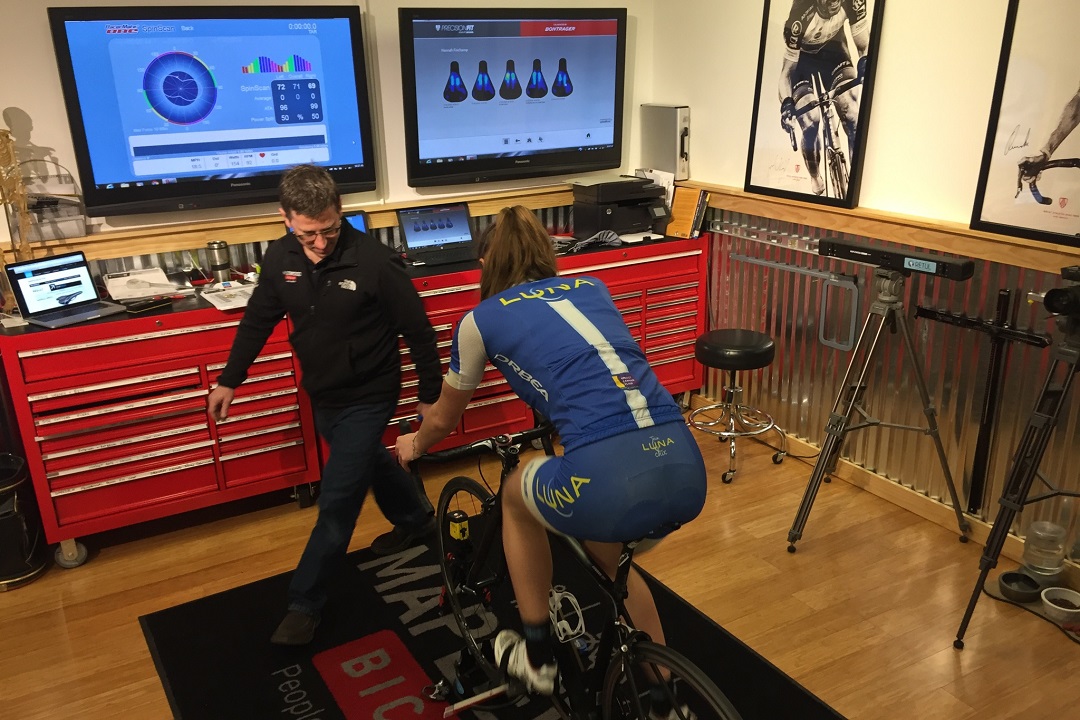Whichever tribe you’re in — mountain biker, roadie, racer, weekend warrior — nearly all bike owners have one thing in common: We love to customize our rides in a variety of ways, from grips and bottle cages in a favorite color to swapping stock handlebars, stems, and seats for improved efficiency or comfort.
But what if your entire bike was custom-built to be a true extension of you? Not just the accessories but the specific dimensions, ride characteristics, and materials?
It’s not as far out of reach as you may think.
“Sometimes riders want a bike that is unique and not from one of the major bike brands,” said Matt LaBerta, who owns LaBerta & Sons Cycles in St. Louis and has spent 26 years in the bike industry. “Other times it has to do with wanting a specific ride quality, being more efficient and comfortable on the bike, or their body shape.”
A custom-built bike begins with a getting a custom fit.
“A custom fit is intended to maximize your efficiency on the bike, so you ride faster, ride farther, and are more comfortable,” said Alex Bischoff, co-owner of The Hub Bicycle Company in Webster Groves. “A custom-built bike takes the benefits of a custom fit to the next logical step. The frame will be shaped to deliver the ride and feel you’re looking for without compromising its handling.”

A custom Seven bike from The Hub Bicycle Co.
During a bike fit session, you’ll be asked a variety of questions about your current bike, riding style, activities you enjoy off the bike, and what you want out the new bike. You’ll also have body measurements taken, including height; arm, inseam, and torso lengths; shoulder width; and more while standing and sitting on your bike and on a specially designed fit system.
“The key is interpreting the data,” said Maplewood Bicycle’s Tim Ray, a Serotta International Cycling Institute certified bike fitter who has spent 30 years in the bike industry.
LaBerta, who has been custom building steel bike frames since 2007, follows a similar approach and then does “everything old school” when it comes to building a frame. “I draw full-scale blueprints for the angles and weld points. The tube set selected for each frame is important, too. A rider’s size, weight, and what they want out of the bike dictate which type of steel and tubes are used. Different brands of steel and tube shapes provide different ride characteristics, with round tubes being the most comfortable.
“Custom touches are essentially endless,” LaBerta continued. “You can pick from a simple welded frame, a lugged frame and add braze-ons for bottles, racks, and fender eyelets, etcetera. I even designed and built a funky, custom rack around a specific bag a guy used and then added it to his bike’s fork.”
Real Riders’ Reactions
Gerrit Segers, who is 6-feet, 5-inches tall and from Wildwood, Missouri, wasn’t initially looking for a custom road bike to replace the larger-sized one he had ridden the past 10 years, but after shopping around and listening to suggestions, he invested in a bike fit.
“Usually, fitting tall riders is a challenge because they aren’t very flexible,” said Ray. “That wasn’t the case with Gerrit. It was quite the opposite. He is very flexible for his height and can easily stretch out into a position better suited to ride faster.”
“I don’t race, but I like to ride fast,” said Segers. “Afterward, I realized I was much more comfortable than on my current bike. It was definitely easier to breathe on the new set up, and I hope that helps me be more efficient on the bike.”
Segers opted for a steel frame with disc brakes, a longer wheelbase for a bit more stable and comfortable ride, and the ability to run larger gravel tires (40c) built by Sycip Bikes in Sonoma County, California.
“[The bike] should be done in June or July,” he said. “I’m excited to have a bike built specifically for me and my size and not having to adjust anything from off the shelf.”

A custom Steelhead bike from Maplewood Bicycle.
On the other end of the spectrum, you’ll find Agnieszka Ferhi. The 5-foot, 1-inch St. Louis resident’s challenge was finding a bike small enough for her size, comfortable, and that would climb beautifully. A custom-designed titanium Steelhead frame — Maplewood Bicycle’s own line of bike — was the answer.
“Previous bikes’ top tubes were too long and caused issues with my lower back and shoulders,” said Ferhi, a former racer and current massage therapist and corrective-exercise trainer. “My new bike is much more comfortable. The sloping top tube accommodates stand-over height, and the longer headtube provides a more upright riding position that alleviates neck and shoulder pain.”
A year ago, Bill Kunz of south St. Louis County was riding a road bike with 25cc tires on gravel and chat roads. After looking at cyclocross bikes and talking to Bischoff at The Hub, he pulled the trigger on a custom-built titanium Seven Axiom S with 32cc tires. Kunz is 6-foot, 5-inches and has been riding the bike for a year now.
“I’m much more comfortable, and my hands don’t fall asleep like before,” he said. “It’s hard to say if my skills and riding have improved as a result of the bike, but it does lead you to make the physical investment to get out there and ride.”
Author: Nick Brennan is a regular contributor to Terrain Magazine.
Featured Image: Tim Ray of Maplewood Bicycle sizes up a cyclist in the fit studio.


Leave A Comment